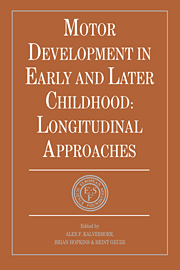Book contents
- Frontmatter
- Contents
- List of contributors
- Foreword
- Preface
- SETTING THE SCENE
- SECTION I BIOLOGICAL BASIS OF MOTOR DEVELOPMENT
- SECTION II DEVELOPMENT OF BODY POSTURE AND GOAL-DIRECTED REACHING
- SECTION III MOTOR DEVELOPMENT, EARLY COMMUNICATION AND COGNITION
- SECTION IV ACQUISITION OF SKILLS
- SECTION V MOTOR DEVELOPMENT AND HANDICAP
- SECTION VI METHODOLOGICAL AND CONCEPTUAL CONSIDERATIONS
- 20 The longitudinal study of motor development: methodological issues
- 21 Theoretical issues in the longitudinal study of motor development
- Epilogue: description versus explanation
- Index
20 - The longitudinal study of motor development: methodological issues
from SECTION VI - METHODOLOGICAL AND CONCEPTUAL CONSIDERATIONS
Published online by Cambridge University Press: 05 May 2010
- Frontmatter
- Contents
- List of contributors
- Foreword
- Preface
- SETTING THE SCENE
- SECTION I BIOLOGICAL BASIS OF MOTOR DEVELOPMENT
- SECTION II DEVELOPMENT OF BODY POSTURE AND GOAL-DIRECTED REACHING
- SECTION III MOTOR DEVELOPMENT, EARLY COMMUNICATION AND COGNITION
- SECTION IV ACQUISITION OF SKILLS
- SECTION V MOTOR DEVELOPMENT AND HANDICAP
- SECTION VI METHODOLOGICAL AND CONCEPTUAL CONSIDERATIONS
- 20 The longitudinal study of motor development: methodological issues
- 21 Theoretical issues in the longitudinal study of motor development
- Epilogue: description versus explanation
- Index
Summary
INTRODUCTION
In most areas of human development, the majority of research findings have been based on cross-sectional designs. Such studies focus on developmental differences among various age groups and ignore developmental changes within individuals over age, which means that they cannot be considered to be truly developmental (cf. McCall, 1977; Wohlwill, 1980). Changes occurring over time within organisms can be assessed only via longitudinal approaches.
The main theme of this chapter is a discussion of methodological issues of longitudinal studies in the area of motor development. In my view, most methodological issues related to the longitudinal assessment of motor development can be easily generalized to other areas of human development. Thus, the reader should keep in mind that, while the various methodological problems considered in this chapter are always linked to topics of motor development, they are not confined to this area of research.
A first general problem concerns the defintion of a longitudinal study. As I noted elsewhere (Schneider, 1989), the term longitudinal does not describe a single method but a large variety of methods. The spectrum of methods ranges from single case studies in time-series arrangements to broad-band panel designs including numerous measurement points and thousands of subjects. The only common denominator of longitudinal research is variation of time and repeated observation of a given entity (cf. Bakes & Nesselroade, 1979).
- Type
- Chapter
- Information
- Motor Development in Early and Later ChildhoodLongitudinal Approaches, pp. 317 - 342Publisher: Cambridge University PressPrint publication year: 1993
- 5
- Cited by



